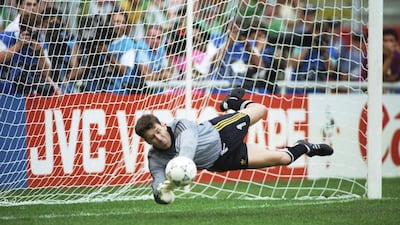The tense silence was broken only by a collective gulp.
“It isn’t? It couldn’t be?”
The Republic of Ireland, a penalty kick away from defeating Romania and qualifying for the quarter-finals at their first World Cup, had placed the hopes of a nation at the feet of … hold on a minute … David O’Leary?
The Arsenal defender may have been well versed in the art of keeping the ball out of the net, but keeping his cool from 12 yards was different altogether.
I could not watch; my family could not watch; “Big Jack” Charlton, English-World-Cup-winner-cum-honorary-Irishman, now trembling on the Genoan touchline, could not watch.
Yet, the Ireland manager need not have feared: David turned Goliath to rifle home from the spot and book his side’s place in the last eight.
In Ireland, fans called for players to be canonised. Saint Packie, Saint Ronnie and Saint Tony had such a groundswell of support that even Pope John Paul II was swept up in the post-Romania delirium, granting the plucky Irishmen an audience at his Vatican headquarters.
Ireland’s passage in 1990 had certainly shocked and startled, although that they arrived there via a penalty shoot-out came as no great surprise.
This was the World Cup of spot kicks, so devoid of real-time goalmouth action that it was widely accepted as the worst in the competition’s 14-tournament history.
Ultra-defensive tactics yielded an average of 2.2 goals per match, a record low that still stands.
Uber-aggressive tackling, with 16 red cards across 52 matches, was unprecedented until that point. The early flickers of Diego Maradona’s decline from his perch at the summit of planet football.
But, honestly, was the ’90 World Cup really that bad?
Perhaps a childish naivety has blurred my perception, but those four weeks at the beginning of that summer laid the platform for a lifelong devotion to the beautiful game.
This was the last World Cup before football morphed into the corporate juggernaut it is today.
Italia ’90 was endearingly unfashionable. Short shorts and billowing tracksuits. Perms, moustaches and mullets – a haircut so lamentable that Chris Waddle discarded it mid-tournament.
Scotland coach Andy Roxburgh’s tartan scarf. West Germany’s abominable World Cup anthem, which was an attack on the senses both aurally and visually; Jurgen Klinsmann introducing global audiences to the air saxophone.
What the competition lacked in perceived quality, it more than made up for in drama. Individual skill was paramount, too.
Paul Gascoigne in his abbreviated pomp for England; a virtuoso Roberto Baggio starring for Italy; Roger Milla and the emergence of the terrifically vibrant Cameroonians.
This World Cup’s legacy should be celebrated. Not long after Andreas Brehme sealed West Germany’s third world title in a tiresome and tetchy final, the back-pass rule was implemented. For every World Cup thereafter, three points would be awarded for a group-game victory. Attacking play was emphasised, actively encouraged.
Ireland contributed to that, as well, having brilliantly bludgeoned their way to the quarters. Charlton’s men managed to delve that far into the tournament by dint of four successive draws, by registering two goals.
While the BBC ensured that Luciano Pavarotti and Nessun Dorma provided the World Cup with its most memorable soundtrack, Ireland laboured and lasted like a bunch of prodigiously pawed bumpkins bashing their way through a bit of Bach.
In short, Italia ’90 made anything seem possible.
jmcauley@thenational.ae
Follow us on Twitter @SprtNationalUAE


